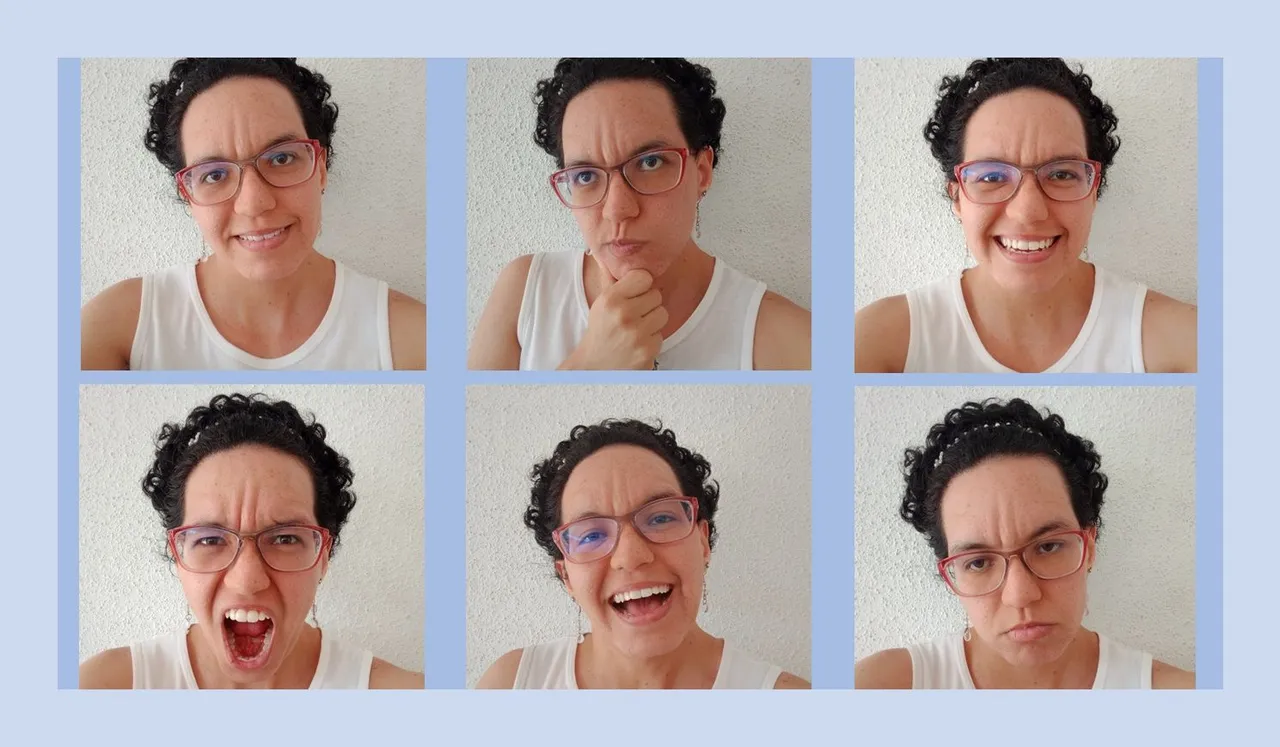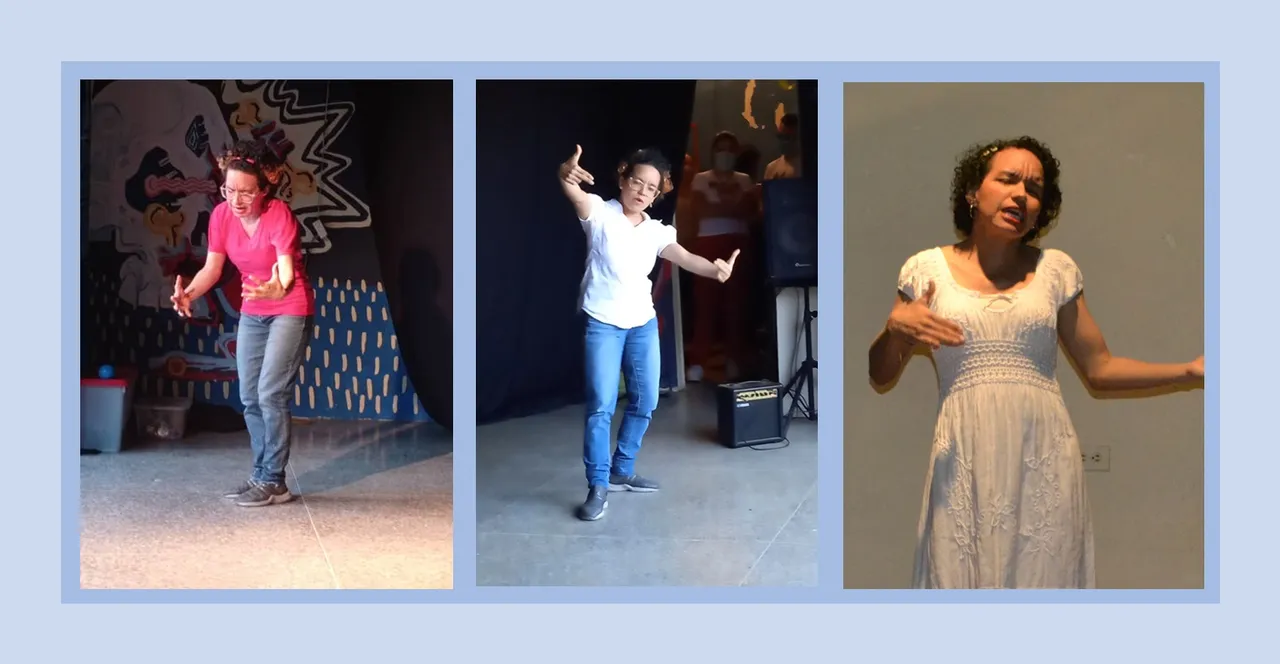
Un saludo a toda la comunidad de Hive, esta semana les quiero hablar sobre los Gestos y el Movimiento en la Escena, en mi experiencia como cuentacuentos han sido muy importantes de aplicar. Además, de que estos ejercicios te obligan a enfrentar el miedo que podemos tener al hacer el ridículo frente a otras personas, la idea es divertirse.
Aunque las personas que se encuentran sentadas lejos de la tarima no puedan ver nuestro rostro, ni las caras que hagamos, de la misma manera a que estemos a 2 metros de distancia, igualmente hay un lenguaje presente en todo nuestro cuerpo y ese si podrá ser visto.
Esta en nuestra naturaleza expresarnos, transmitir a otros algún mensaje no verbal mediante gestos que hacemos con nuestro cuerpo, los sentimientos que estamos sintiendo. En el caso del teatro o alguna otra presentación escénica, hacemos interpretaciones, los actores o, en mi caso narradores orales, interpretamos el mensaje que queremos transmitir y le damos esa intención con el uso de gestos y movimientos.

Si bien, los gestos nos ayudan a entender las características de los personajes y por la situación que están pasando, también son un elemento del que nos podemos valer para dar alguna explicación, como cuando pedimos u ordenamos hacer silencio, o cuando se está cavando algo, son detalles que no requieren alguna narración ni explicación, sino simplemente ser observados.
Por otro lado, tenemos también el movimiento escénico; a nosotros nos enseñan los nombres de las partes del escenario (aunque a veces se me olvidan); entre ellas tenemos el Proscenio, es la parte del escenario que se encuentra más cercana al público y sólo nos pondremos ahí si es necesario, sino no, por la manera en la que la luz es apuntada hacia el escenario, para los actores o las personas que se encuentran haciendo una presentación, la luz puede ser un tanto cegadora aunque necesaria (porque nos apunta a la cara) y al alejarnos de su rango hace que el público que se encuentra más lejano no nos pueda ver bien, y estar en el proscenio puede alejarnos del rango de la luz.
El movimiento en escena también sirve para delimitar y marcar espacios durante la narración, si bien podemos contar con algunos objetos como sillas o mesas, cuando contamos historias, los personajes pueden viajar a cualquier lugar, y debemos aprender a diferenciar esas escenas. Cada historia puede contar con un movimiento escénico diferente.
Por ejemplo: yo cuento un cuento titulado: El Testigo, escrito por Marcela Serrano, y para describir los diferentes escenarios, yo marco: la piscina al lado derecho del escenario, la casa grande en el centro, y las hectáreas de árboles frutales al lado izquierdo. Y en la medida que voy narrando la historia me voy movilizando en los lugares que los personajes transitan.
Las fotos y el collage son de mi autoría; si gustan pueden seguirme en mis redes sociales:
Facebook, @riverourama
Instagram, @riverourama
"X" , @riverourama
Hive, @uramarivero
Gracias por leerme, feliz día 🌼
English Version
.

Greetings to all the Hive community, this week I want to talk about Gestures and Movement in the Scene, in my experience as a storyteller they have been very important to apply. Besides the fact that these exercises force you to face the fear we may have of making a fool of ourselves in front of other people, the idea is to have fun.
Although people sitting far away from the stage cannot see our face, or the faces we make, even if we are 2 meters away, there is still a language present in our whole body, and it can be seen.
It is in our nature to express ourselves, to transmit to others some non-verbal message through gestures that we make with our body, the feelings that we are feeling. In the case of theater or any other scenic presentation, we make interpretations, the actors or, in my case, oral narrators, we interpret the message we want to transmit, and we give that intention with the use of gestures and movements.

While gestures help us to understand the characteristics of the characters and the situation they are going through, they are also an element that we can use to give an explanation, such as when we ask or order to be quiet, or when something is being dug, they are details that do not require any narration or explanation, but simply to be observed.
On the other hand, we also have the stage movement; we are taught the names of the parts of the stage (although sometimes I forget them); Among them, we have the Proscenium, it is the part of the stage that is closest to the audience, and we will only stand there if it is necessary, otherwise not, because of the way the light is pointed towards the stage, for the actors or the people who are doing a presentation, the light can be a bit blinding although necessary (because it is pointed at our face) and when we move away from its range it makes the audience that is farther away can not see us well, and being in the proscenium can move us away from the range of the light.
The movement on stage also serves to delimit and mark spaces during the narration, although we can count on some objects such as chairs or tables, when we tell stories, the characters can travel anywhere, and we must learn to differentiate those scenes. Each story can have a different scenic movement.
For example: I tell a story entitled: The Witness, written by Marcela Serrano, and to describe the different scenarios, I mark: the swimming pool on the right side of the stage, the big house in the center, and the acres of fruit trees on the left side. And as I narrate the story, I move around the places the characters pass through.
The photos and collage are of my authorship; if you like you can follow me on my social networks:
Facebook, @riverourama
Instagram, @riverourama
"X" , @riverourama
Hive, @uramarivero
Thanks for reading, happy day 🌼